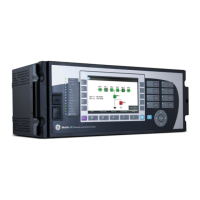CHAPTER 8: APPLICATION OF SETTINGS SERIES COMPENSATED LINES
L90 LINE CURRENT DIFFERENTIAL SYSTEM – INSTRUCTION MANUAL 8-21
8
forward fault. The time window of allowing the scheme to operate when no DCUB RX signal is received when any loss-of-
guard was received is the difference between the
DCUB LOG TRIP WINDOW and DCUB LOG PICKUP DELAY timers. When using
default settings, this value is 150 – 8 = 142 ms. This means the scheme is unblocked and can trip during this time window if
a forward fault is sensed.
8.5.7.4 Keying of the carrier(s) under normal conditions
The keying signals, which allows the relay to key the permissive channel during normal permissive scheme operation by
means of the DCUB TX1 through DCUB TX4 signals, are established as follows:
• The scheme is enabled (
DCUB FUNCTION is “Enabled” and DCUB BLOCK is “Off”), and
• a fault is seen in the forward zone 2 distance elements or ground directional forward function (if configured), and
• the reverse zone 4 distance elements or ground directional reverse function (if configured) did not pickup to set the
transient blocking.
If these conditions are met, then the scheme keys the channel(s) by means of asserting transmit signals DCUB TX1 through
DCUB TX4 with the aid of the local phase selector or zone 2 distance elements.
8.5.7.5 Keying of the carrier during echo conditions
The echo signal, which allows the relay to key the permissive channel(s) through the DCUB TX1 through DCUB TX4 transmit
operands during echo conditions when the local breaker opened, keys the carrier(s) during the following conditions:
• The scheme is enabled (
DCUB FUNCTION is “Enabled” and DCUB BLOCK is “Off”), and
•the
DCUB PERMISSIVE ECHO setting is “Enabled”, and
•the LINE PICKUP LEO PKP operand that detects the local breaker to be open picks up for a time set by
LINE END OPEN
PICKUP DELAY
, and
• any permissive signal DCUB RX1 through DCUB RX4 is received and any LOG1 to LOG4 is received, and
• a fault is not seen in the forward zone 2 distance elements or ground directional forward function (if configured) for at
least 100 ms, and
• the reverse zone 4 distance elements or ground directional reverse function (if configured) did not pickup to set the
transient blocking.
If these conditions are met, then the scheme echoes (transmits the DCUB TX1 through DCUB TX4 operands) the received
permissive DCUB RX signal(s) back to the remote relay based on the echo table.
The keying or transmit signals DCUB TX1 through DCUB TX4 consist of all normal keying or echo keying conditions.
The scheme DCUB TRIP A, DCUB TRIB B, DCUB TRIP C, and DCUB TRIP 3P output operands are hard-wired to the trip output
scheme. As such, if the trip output or breaker control operands (if the breaker control function is used) are used for tripping,
the scheme is fully operational. The permissive key carrier signals DCUB TX1 through DCUB TX4 must still be assigned to the
tripping/operating logic, and to output contacts as per the usual L90 logic/output assignments.
8.6 Series compensated lines
8.6.1 Distance settings
Traditionally, the reach setting of an underreaching distance function is set based on the net inductive impedance
between the potential source of the relay and the far-end busbar, or location for which the zone must not overreach. Faults
behind series capacitors on the protected and adjacent lines need to be considered for this purpose. For further
illustration, a sample system shown in the figure is considered.

